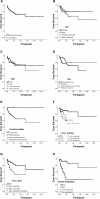Relationship between clinical characteristics and survival of gastroenteropancreatic neuroendocrine neoplasms: A single-institution analysis (1995-2012) in South China
- PMID: 23194346
- PMCID: PMC3526557
- DOI: 10.1186/1472-6823-12-30
Relationship between clinical characteristics and survival of gastroenteropancreatic neuroendocrine neoplasms: A single-institution analysis (1995-2012) in South China
Abstract
Background: Gastroenteropancreatic neuroendocrine neoplasm (GEP-NEN) is the most common type of neuroendocrine tumors accounting for 65-75% of neuroendocrine neoplasms (NENs). Given the fact that there are few studies on GEP-NENs among Chinese patients, we performed a retrospective study in South China.
Methods: Totally 178 patients with GEP-NENs treated at the First Affiliated Hospital of Sun Yat-sen University between January 1995 and May 2012 were analyzed retrospectively.
Results: Pancreas was found the most common site of involvement (34.8%). 149 patients (83.7%) presented as non-functional tumors with non-specific symptoms such as abdominal pain (33.7%); carcinoid syndrome was not found in this study. Several methods are useful for localization of GEP-NENs, yielding varied detection rates from 77.8% to 98.7%. Positive rates of chromogranin A (CgA) and synaptophysin (Syn) immunhistochemically were 69.1% and 90.2%, respectively. 87 patients (51.5%) had G1 tumors, 31(18.3%) G2 tumors and 51 (30.2%) G3 tumors. Neuroendocrine tumor (NET), neuroendocrine carcinoma (NEC) and mixed adenoendocrine carcinoma (MANEC) were 69.8%, 27.2% and 3.0%, respectively. 28.1% of patients presented with distant disease. Surgery was performed in 152 (85.4%) patients, and overall 5-year survival rate was 54.5%. Functionality, G1 grading and NET classification were associated with favorable prognosis in univariate analysis. Distant metastasis contributed to unfavorable prognosis of these tumors.
Conclusions: Nonfunctional tumors with non-specific symptoms account for the majority of GEP-NENs. Diagnosis depends on pathological classification. Multidisciplinary treatments could help improve the outcome.
Figures

References
-
- Yao JC, Hassan M, Phan A, Dagohoy C, Leary C, Mares JE, Abdalla EK, Fleming JB, Vauthey JN, Rashid A. et al.One hundred years after “carcinoid”: epidemiology of and prognostic factors for neuroendocrine tumors in 35,825 cases in the United States. J Clin Oncol. 2008;26(18):3063–3072. doi: 10.1200/JCO.2007.15.4377. - DOI - PubMed
-
- Bosman FT, Carneiro F, Hruban RH, Theise ND. WHO classification of tumours of the digestive system. 4. Lyon: International Agency for Research on Cancer; 2010.
-
- Chinese Pathologic Consensus Group for Gastrointestinal and Pancreatic Neuroendocrine Neoplasm. China Consensus Guidelines for the standards of histopathologic diagnosis in Gastroenteropancreatic Neuroendocrine neoplasm. Chin J Pathol. 2011;40(4):257–262. - PubMed
LinkOut - more resources
Full Text Sources
Research Materials
Miscellaneous

